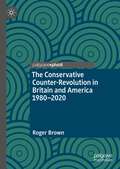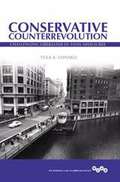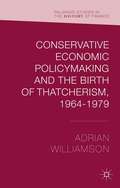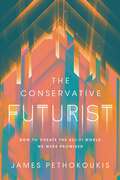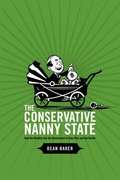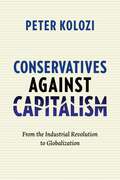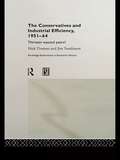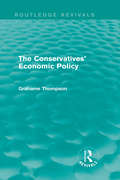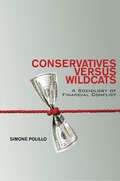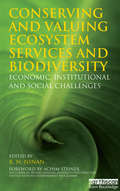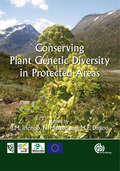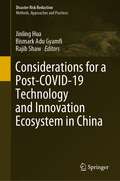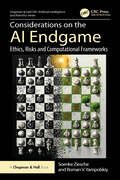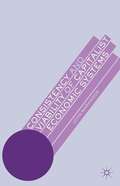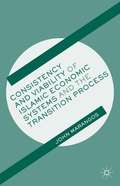- Table View
- List View
The Conservative Counter-Revolution in Britain and America 1980-2020
by Roger BrownThis book assesses the impacts of the right within the US and UK, forty years on from their initial effects upon economic and social orthodoxies. It argues that one way of understanding the main developments in the political economies of the major Anglophone countries during these decades is to see them as a conservative reaction to the New Deal and the Welfare State, and the associated growth in state intervention, expenditure and regulation. The recent rise in ‘authoritarian populism’ can be seen as a popular response to the policies associated with this reaction, the response being exploited by populist demagogues like Donald Trump, Boris Johnson and Marine Le Pen. Written in a lively and engaging manner, this book will be of interest to academics and students in politics, economics, sociology and contemporary history, as well as general readers.
Conservative Counterrevolution: Challenging Liberalism in 1950s Milwaukee
by Tula A ConnellIn the 1950s, Milwaukee's strong union movement and socialist mayor seemed to embody a dominant liberal consensus that sought to continue and expand the New Deal. Tula Connell explores how business interests and political conservatives arose to undo that consensus, and how the resulting clash both shaped a city and helped redefine postwar American politics. Connell focuses on Frank Zeidler, the city's socialist mayor. Zeidler's broad concept of the public interest at times defied even liberal expectations. At the same time, a resurgence of conservatism with roots presaging twentieth-century politics challenged his initiatives in public housing, integration, and other areas. As Connell shows, conservatives created an anti-progressive game plan that included a well-funded media and PR push; an anti-union assault essential to the larger project of delegitimizing any government action; opposition to civil rights; and support from a suburban silent majority. In the end, the campaign undermined notions of the common good essential to the New Deal order. It also sowed the seeds for grassroots conservatism's more extreme and far-reaching future success.
Conservative Economic Policymaking and the Birth of Thatcherism, 1964–1979
by Adrian WilliamsonIn this book, Adrian Williamson investigates the processes by which Thatcherism became established in Tory thinking, and questions to what extent the politician herself is responsible for Thatcherism within the Conservative Party.
The Conservative Futurist: How to Create the Sci-Fi World We Were Promised
by James PethokoukisDiscover the surprising case for how conservatism can help us achieve the epic sci-fi future we were promised. America was once the world&’s dream factory. We turned imagination into reality, from curing polio to landing on the Moon to creating the internet. And we were confident that more wonders lay just over the horizon: clean and infinite energy, a cure for cancer, computers and robots as humanity&’s great helpers, and space colonies. (Also, of course, flying cars.) Science fiction, from The Jetsons to Star Trek, would become fact. But as we moved into the late 20th century, we grew cautious, even cynical, about what the future held and our ability to shape it. Too many of us saw only the threats from rapid change. The year 2023 marks the 50th anniversary of the start of the Great Downshift in technological progress and economic growth, followed by decades of economic stagnation, downsized dreams, and a popular culture fixated on catastrophe: AI that will take all our jobs if it doesn&’t kill us first, nuclear war, climate chaos, plague and the zombie apocalypse. We are now at risk of another half-century of making the same mistakes and pushing a pro-progress future into the realm of impossibility. But American Enterprise Institute (AEI) economic policy expert and long-time CNBC contributor James Pethokoukis argues that there&’s still hope. We can absolutely turn things around—if we the people choose to dream and act. How dare we delay or fail to deliver for ourselves and our children. With groundbreaking ideas and sharp analysis, Pethokoukis provides a detailed roadmap to a fantastic future filled with incredible progress and prosperity that is both optimistic and realistic. Through an exploration of culture, economics, and history, The Conservative Futurist tells the fascinating story of what went wrong in the past and what we need to do today to finally get it right. Using the latest economic research and policy analysis, as well as insights from top economists, historians, and technologists, Pethokoukis reveals that the failed futuristic visions of the past were totally possible. And they still are. If America is to fully recover from the COVID-19 pandemic, take full advantage of emerging tech from generative AI to CRISPR to reusable rockets, and launch itself into a shining tomorrow, it must again become a fully risk-taking, future-oriented society. It&’s time for America to embrace the future confidently, act boldly, and take that giant leap forward.
The Conservative Nanny State: How the Wealthy Use the Government to Stay Rich and Get Richer
by Dean BakerEconomist Dean Baker debunks the myth that conservatives favor the market over government intervention. In fact, conservatives rely on a range of "nanny state" policies that ensure the rich get richer while leaving most Americans worse off. It's time for the rules to change. Sound economic policy should harness the market in ways that produce desirable social outcomes -- decent wages, good jobs and affordable health care. Dean Baker is co-director of the Center for Economic and Policy Research.
Conservatives Against Capitalism: From the Industrial Revolution to Globalization
by Peter KoloziFew beliefs seem more fundamental to American conservatism than faith in the free market. Yet throughout American history, many of the major conservative intellectual and political figures have harbored deep misgivings about the unfettered market and its disruption of traditional values, hierarchies, and communities. In Conservatives Against Capitalism, Peter Kolozi traces the history of conservative skepticism about the influence of capitalism on politics, culture, and society.Kolozi discusses conservative critiques of capitalism—from its threat to the Southern way of life to its emasculating effects on American society to the dangers of free trade—considering the positions of a wide-ranging set of individuals, including John Calhoun, Theodore Roosevelt, Russell Kirk, Irving Kristol, and Patrick J. Buchanan. He examines the ways in which conservative thought went from outright opposition to capitalism to more muted critiques, ultimately reconciling itself to the workings and ethos of the market. By analyzing the unaddressed historical and present-day tensions between capitalism and conservative values, Kolozi shows that figures regarded as iconoclasts belong to a coherent tradition, and he creates a vital new understanding of the American conservative pantheon.
The Conservatives and Industrial Efficiency, 1951-1964: Thirteen Wasted Years? (Routledge Explorations in Economic History)
by Nick Tiratsoo Jim TomlinsonThe Conservatives and Industrial Efficiency, 1951-1964 responds to the need for a full assessment of the Conservatives performance in this crucial period. Drawing upon a wide range of archival sources, Nick Tiratsoo and Jim Tomlinson explore the different aspects of the efficiency question. Beginning with the major issue of attempts in the 1950s to americanize British industry, the authors also discuss the Conservatives policy on ompetition, education and training, investment and research and development. This new survey reveals that the Conservatives were informed about each of these issues, yet shrank from effective reform. They were, rather, reduced to inertia by ideological dilemmas, internal party antagonisms and conflicting strategic objectives. Tiratsoo and Tomlinson conclude that 1951 - 1964 were indeed 'thirteen wasted years'. This book will be of interest to all those concerned with the post-1945 economic and political history of Britain.
The Conservatives' Economic Policy (Routledge Revivals)
by Grahame ThompsonWhat happened to economic policy during the first five years of Mrs Thatcher’s government? Most commentators have emphasised the radical changes wrought in economic theory and policy over the period from 1979. The left saw this as heralding the introduction of the social market economy and authoritarian populism, the right saw it as evangelical monetarism and a new beginning. This book, first published in 1986, challenges the notion that there was a revolution in economic policy making. It emphasises the constraints on economic policy formation and the ironies that these have thrown up with respect to the Conservatives’ attempts at changing the course of the economy. The book argues that the Thatcher government had not been able to implement a great deal of its rhetoric. This book is ideal for students of economics and politics.
Conservatives Versus Wildcats: A Sociology of Financial Conflict
by Simone PolilloFor decades, the banking industry seemed to be a Swiss watch, quietly ticking along. But the recent financial crisis hints at the true nature of this sector. As Simone Polillo reveals inConservatives Versus Wildcats, conflict is a driving force. Conservative bankers strive to control money by allying themselves with political elites to restrict access to credit. Barriers to credit create social resistance, so rival bankers—wildcats—attempt to subvert the status quo by using money as a tool for breaking existing boundaries. For instance, wildcats may increase the circulation of existing currencies, incorporate new actors in financial markets, or produce altogether new financial instruments to create change. Using examples from the economic and social histories of 19th-century America and Italy, two decentralized polities where challenges to sound banking originated from above and below, this book reveals the collective tactics that conservative bankers devise to legitimize strict boundaries around credit—and the transgressive strategies that wildcat bankers employ in their challenge to this restrictive stance.
Conserving and Valuing Ecosystem Services and Biodiversity: Economic, Institutional and Social Challenges
by K. N. NinanThis book comprehensively addresses the economic, social and institutional difficulties in conserving biodiversity and the ecosystem services that it provides. It covers a wide range of issues such as biodiversity, ecosystem services and valuation in the context of diverse ecosystems such as tropical forests, marine areas, wetlands and agricultural landscapes, non-timber forest products, incentives and institutions, payments for ecosystem services, governance, intellectual property rights and the protection of traditional knowledge, management of protected areas, and climate change and biodiversity. It also covers the application of environmental economics and institutional economics to different cases and the use of techniques such as contingent valuation method and game theory. The book spans the globe with case studies drawn from a cross section of regions and continents including the UK, US, Europe, Australia, India, Africa and South America.
Conserving Plant Genetic Diversity in Protected Areas: Population Management of Crop Wild Relatives
by José María Iriondo Nigel Maxted Mohammad Ehsan DullooRather than the usual focus on rare or endangered plants and ex situ efforts in conserving plant biodiversity, Iriondo (biodiversity and conservation, U. Rey Juan Carlos, Madrid, Spain) and the co-editors are devoted to the conservation of the genetic diversity of crop wild relatives in their natural environments. After presenting the increasingly urgent rationale for such conservation efforts, contributors to seven chapters address international/national initiatives including integrating efforts to maintain plant diversity with protected area management, issues in reserve location and design, monitoring technologies, and habitat recovery techniques. The volume includes highlighted case studies, and color plates of plants, interaction with local peoples for successful wild relative crop conservation, monitoring activities, a gene bank, and native plant nursery. Annotation ©2008 Book News, Inc., Portland, OR (booknews.com)
Consider a Spherical Patent: IP and Patenting in Technology Business
by Joseph E. GortychGet Critical Insight into the Modern Patenting Scene We are now living in the "IP Era of the Information Age" where technology businesses are placing increasing emphasis on intellectual property (IP) as a way to add to their bottom lines. As a consequence, those working in a technology business or organization will inevitably be thrust into working
Consider Your Calling: Six Questions for Discerning Your Vocation
by Gordon T. SmithCourage and Calling
Considerations for a Post-COVID-19 Technology and Innovation Ecosystem in China (Disaster Risk Reduction)
by Jinling Hua Bismark Adu Gyamfi Rajib ShawCOVID-19 has made differential impacts on countries and communities around the world. China, where COVID-19 started, has developed and utilized different types of technologies, including both traditional and disruptive technologies, to address the pandemic risks. Also, there have been many innovations in applying technologies in different contexts during the pandemic as well as in the post-pandemic recovery and preparedness aspects. This book covers some of these technological developments as well as the governance mechanisms for developing a technology and innovation ecosystem in a post-COVID-19 context in China. The book also explores the experiences and lessons learned from different types of technologies and their implementation in the post-COVID-19 period and highlights how they can be useful to prepare for future calamities.
Considerations for Integrating Women into Closed Occupations in U.S. Special Operations Forces
by Zev Winkelman William Marcellino Thomas S. Szayna Sean Robson Miriam Matthews Marek N. Posard Lynsay Ayer Lisa Kraus James Syme J. Michael Polich Eric V. Larson Derek Eaton Cameron Wright Angela O'Mahony Agnes Gereben SchaeferIntegrating women into special operations forces poses potential challenges for unit cohesion. The integration of women raises issues of effectiveness, in terms of physical standards and ensuring the readiness, cohesion, and morale essential to high-performing teams. This report assesses those challenges and provides analytical support for validating occupational standards for positions controlled by U.S. Special Operations Command.
Considerations in Applying Benefit-Cost Analysis to Preventive Interventions for Children, Youth, and Families
by Steve OlsonBenefit-cost analyses hold great promise for influencing policies related to children, youth, and families. By comparing the costs of preventive interventions with the long-term benefits of those interventions, benefit-cost analysis provides a tool for determining what kinds of investments have the greatest potential to reduce the physical, mental, and behavioral health problems of young people. More generally, the growth of benefit-cost analysis as a field of research and practice represents an exciting and promising trend in the development and implementation of public policies. The utility of benefit-cost analyses has been limited by a lack of uniformity in the methods and assumptions underlying these studies. For years, those who perform and those who use benefit-cost analyses have argued that the development and use of theoretical, technical, and reporting standards for benefit-cost analyses would enhance the validity of results, increase comparability across studies, and accelerate the progress of the field. Considerations in Applying Benefit-Cost Analysis to Preventive Interventions for Children, Youth, and Families is the summary of a workshop convened by the Board on Children, Youth, and Families of the Institute of Medicine and the National Research Council in November 2013 as the first phase of a possible two-part effort directed toward guiding future benefit-cost studies and enhancing the relevance of benefit-cost analysis to governments and other organizations wanting to make sound prevention decisions. The workshop brought together leading practitioners in the field, researchers who study the methodological and analytic dimensions of benefit-cost analysis, and representatives of organizations that use the results of benefit-cost analyses to shape and implement public policies. This report discusses a wide range of issues about benefit-cost analysis, including the level of research rigor that should be met before results from an evaluation are used to estimate or predict outcomes in a cost-benefit analysis; best practices and methodologies for costing prevention interventions; prevention outcomes that currently lend themselves to monetization; processes and methodologies that should be used when linking prevention outcomes to avoided costs or increased revenues; and best methods for handling risk and uncertainty in estimates.
Considerations on the AI Endgame: Ethics, Risks and Computational Frameworks (Chapman & Hall/CRC Artificial Intelligence and Robotics Series)
by Soenke Ziesche Roman V. YampolskiyThis seminal volume offers an interdisciplinary exploration into the rapidly evolving field of artificial intelligence and its societal implications. Written by leading scholars Soenke Ziesche and Roman V. Yampolskiy, the book delves into a multitude of topics that address the rapid technological advancements in AI and the ethical dilemmas that arise as a result.The topics explored range from an in-depth look at AI welfare science and policy frameworks to the mathematical underpinnings of machine intelligence. These subjects include discussions on preserving our personal identity in technological contexts as well as on the question of AI identity, innovative proposals towards the critical AI value alignment problem and a call to merge Western and non-Western approaches towards universal AI ethics. The work also introduces unconventional yet crucial angles, such as the concept of "ikigai" in AI ethics and a pioneering attempt to map a potential AI-driven ikigai universe as well as the role of design formalisation, or "Designometry," in the creation of artefacts.By offering a balanced mix of theoretical and applied insights, the book serves as an invaluable resource for researchers, policymakers and anyone interested in the future of AI and the extent of its impact on society.
Considerations on the Fundamental Principles of Pure Political Economy (Routledge Studies in the History of Economics)
by Vilfredo ParetoBetween May 1892 and October 1893 the Giornale degli Economisti published Vilfredo Pareto’s Considerazioni sui principi fondamentali dell’economia politica pura in five parts. Viewed in its entirety, the outcome is essentially a classic monograph on the fundamental issues in pure economic theory in the Lausanne tradition. Pareto's work forms a document of major historical significance which, to date, has only been available to the relatively small number of international economists and historians of economics who read Italian. This first English language edition is a significant landmark in the history of economics.
Considering Computer Contracting?: The Computer Weekly Guide To Becoming A Freelance Computer Professional (Computer Weekly Professional Ser.)
by Michael PowellConsidering computer contracting?If you are, then read this book. It explores the many aspects of the computer contracting world and gives sound practical advice to both the newcomer and the experienced contractor. It will also be invaluable if you are an employer wrestling with the perennial problem of finding staff in this highly competitive marketplace.Let this book show you how to break loose from being an employee to working freelance. The author, a freelancer himself, considers what it takes to become a contract worker and gives you invaluable information throughout to help you get started in the world of computer contracting. This book looks at:* why contract workers are used at all - what kind of companies actually employ contractors, and why?* how you make the transition from full-time working - what does it actually take temperamentally to be a successful contractor?* how you start - what does forming your own company involve, and why is it even necessary?* how you go about finding a contract, and negotiating the right rate.* what agencies do for you - and how can you find who are the best?* the financial differences between being a full-time employee and a contractor - how do you manage your affairs?* how you keep your experience up to date when you do not have a regular employer to help train you.* what sort of opportunities are available, and what sort of rates of pay you can expect.* your possible career progressions after contracting.The contracting scene is ever changing. In this wide-ranging book, the current outlook for contract staff is analysed as well as the trends in the computer industry which are driving these changes. Some doors are opening whilst other close - let this book be your guide.If you have marketable skills, the right attitude and would like to be your own boss, there could not be a better time to consider computer contracting.
Consiga el trabajo que en verdad necesita
by James CaanCon una situación del mercado de trabajo tan difícil, más que nunca es necesario detectar las oportunidades realmente interesantes, destacar por encima de los demás, y contar con la mejor estrategia para conseguir su objetivo. Consiga el trabajo que en verdad desea le muestra, paso a paso, cómo mantener una actitud positiva frente a las dificultades, destacar para conseguir una entrevista y, una vez ahí, desplegar toda su capacidad y pasión, hasta conquistar ese puesto que siempre ha deseado.«Magníficos consejos de principio a fin. Lo recomendamos a todos nuestros candidatos.»Keith Potts, director ejecutivo, Jobsite
Consiga un trabajo hoy (How to Write a Resume and Get a Job)
by Luis CortesConsiga Un Trabajo Hoy Encontrar un empleo puede ser una tarea estresante. Hasta resulta difícil saber por dónde comenzar. ¿Dónde están las listas de empleos? ¿Qué destrezas se requieren? ¿Cómo puede hacer que su hoja de vida se destaque? La búsqueda de un empleo conlleva muchas reglas que usted no puede quebrantar, y es fácil que inadvertidamente usted reduzca sus oportunidades. En Consiga un trabajo hoy, el Rdo. Luis Cortés le brinda a usted la información necesaria para obtener un empleo prometedor. Este libro lo conduce paso a paso a través de todo el proceso, desde la búsqueda y la solicitud de empleo, hasta la negociación de un mejor salario y la petición de beneficios. Un empleo no lo es todo en la vida, pero sí la llave de un futuro mejor. Este libro le garantiza que su búsqueda será exitosa.
Consigli per il business autonomo da casa (Come fare... #27)
by Owen JonesConsigli per il business autonomo da casa Molte persone sono tentate di provare a provare l'attività del marketing di affiliazione, perché commettono l'errore di credere a un mito quale realtà. Prima di tutto, forse, è che credono che gestire un'azienda su Internet sia facile e, in secondo luogo, è che pensano che si possano fare molti soldi con il marketing su Internet nel giro di una sola notte. Forse nemmeno lo 0,1% di coloro che si occupano di marketing affiliato diventano ricchi velocemente. Ci possono essere alcune persone che hanno raggiunto un grande successo in un breve periodo di tempo dopo la creazione di un sito web del programma di affiliazione, ma nessuno di loro dirà sinceramente che è stata solo fortuna. Chiunque stia facendo bene in questo tipo di business vi dirà che ha lavorato molto duramente per arrivare dove si trova ora. Il successo nel marketing di affiliazione richiede tempo e duro lavoro, ma ne vale la pena. Se state pianificando di iniziare un programma di affiliazione, una delle cose a cui dovete pensare è creare il vostro sito web e non un sito web ordinario, ma un sito dall'aspetto professionale. Come si crea un sito web di marketing di affiliazione? Quali sono i passi per crearne uno? Beh, per prima cosa dovete aver già deciso il tema o la nicchia del vostro sito web. Sarebbe meglio se aveste già un'idea di quali prodotti o servizi vorreste commercializzare, visto che questo vi aiuterà a tracciare il design e il layout delle vostre pagine web. La prossima cosa da fare è decidere il nome di un dominio e gestirlo in hosting. Il nome di dominio è il nome esclusivo utilizzato per etichettare l'URL del vostro sito web su Internet. Quando decidete quale nome di dominio registrare, esaminate il tipo di merce che state commercializzando e il relativo contenuto del vostro sito.
Consigli utili per risparmiare quotidianamente
by Jaime Villata C. Luca CatalanoSiamo una minaccia!… Quando maneggiamo il denaro… e questa è la triste realtà, per quante scuse possiamo cercare pur di negarlo. Questo modo di fare è palese quando desideriamo risparmiare, ma ci nascondiamo dietro la scusa che non abbiamo sufficienti entrate per farlo, per questo, se vogliamo migliorare la nostra capacità nel risparmiare dovremmo evitare di andare così spesso al bancomat, adesso ti diremo perché. Se il nostro obbiettivo è risparmiare, dobbiamo fare in modo di lasciare i nostri soldi sul conto bancario il più possibile, perché è importante farlo? La risposta è semplice, ti permette di avere le spese sotto controllo, con più ordine ed organizzazione. Le statistiche indicano che ritiriamo al bancomat più di una volta a settimana, sicuramente, una frequenza che è diminuita rispetto agli anni precedenti. In questo libro ti offro alcuni suggerimenti che a me sono risultati utili.
Consistency and Viability of Capitalist Economic Systems
by John MarangosConsistency and Viability of Capitalist Economic Systems develops an original analytical framework to understand the relationship between the economic, political, and ideological structures, the external environment, and the process of reform that give rise to certain economic systems by establishing consistency.
Consistency and Viability of Islamic Economic Systems and the Transition Process
by John MarangosConsistency and Viability of Islamic Economics Systems and the Transition Process has the crucial intention of stimulating interest in Islamic economics by studying the Islamic Republic of Iran using the analytical framework of consistency and viability. This text develops an original analytic framework to understand the relationship between the economic, political, and ideological structures, the external environment, and the process of reform that gives rise to certain economic systems by establishing consistency. Consistency, however, is not enough; a consistent economic system must be flexible and have the internal mechanisms to be able to adapt to changes in social reality, thus making possible its survival over time. In other words, the economic system is viable when it is able to encourage increases in labor productivity and there is popular support. The collapse of centrally administered socialism in Central and Eastern Europe and the former Soviet Union resulted in what was commonly referred to as the transition problem.
